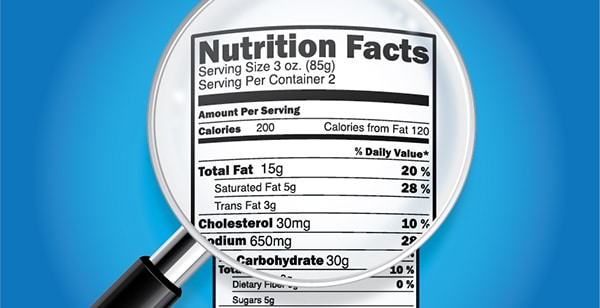 5-star Fitness
5-star Fitness
 5-star Fitness
5-star Fitness

Unfortunately, deciphering nutrition labels can be tricky – but it doesn’t have to be! The FDA has designed nutrition fact labels to provide us with the most relevant information about our food. So, how can we make sense of all these numbers and know what to look out for?
By taking a closer look at the five key areas – Serving size, Calories, Nutrients, Daily Values, and Ingredients – you can begin to make more conscious and informed decisions when it comes to the food choices you make. Let’s break it down and find out!
At the top of any nutrition label will be the serving size as well as how many servings are in a given container. The serving size is based on what an average person consumes and is not necessarily a recommendation on how to eat. Be mindful of how many servings are in a container. For example, many cans of soup are two or three servings per can, so if you are consuming an entire container of soup for a meal, the nutrition values should be multiplied by the number of servings.
This is the first number that most people look at on a label, however this is not the most important number to review. Check out my blog on “counting calories” for why calories are not the most accurate measure of energy intake or expenditure. Calories are calculated by burning a food and measuring the increase in water temperature. The average calories per macronutrient is 4 kcal per gram of protein and carbohydrates and 9 kcal per gram from fat. Food manufacturers do not burn up each new food product to calculate the calories instead they simply take an estimate of the amounts of each macronutrient present in the food. This creates some inaccuracies and nutrition labels are allowed to have up to 20 percent margin of error for the listed value versus the actual value of nutrients.
At each meal at PFC we want to have a balanced amount of macronutrients. When building a meal look for the following ranges:
The percent Daily Value (%DV) is the reference amounts (expressed in grams or milligrams) of nutrients to consume or not exceed each day.
Listed in order by weight , so first on the list will be most prevalent. Try to choose foods where you can recognize most of the listed ingredients.
The bottom line: If you are looking for a simple and quick way to make healthier decisions, Nutrition Labels can be your secret weapon! Between the seductive marketing terms like ‘light’, ‘natural,’ or ‘reduced fat/sodium/etc’, it’s no wonder why it can be hard to trust what’s written on the front of the package. However, you’re not powerless to marketing ploys. The nutrition label on the back of the product can provide reliable information that can help you make healthier decisions. Next time you’re grocery shopping, make sure to read the nutrition label before you buy. It could be the difference between you making a healthy choice and an unhealthy one.
Delany Smith, Certified Nutrition Coach
PFC Nutrition Educator & Dietary Coordinator
Image Source: CDC